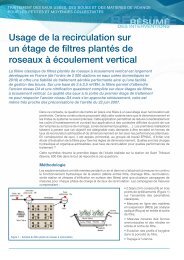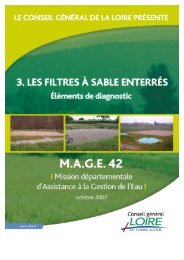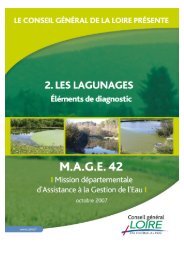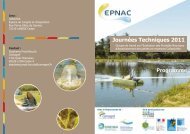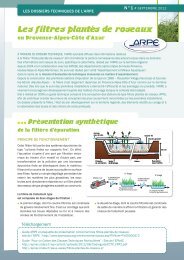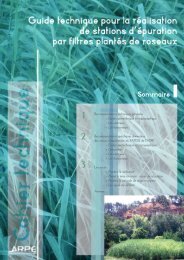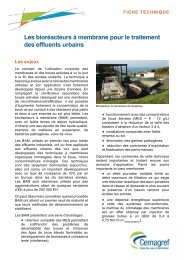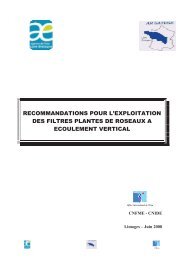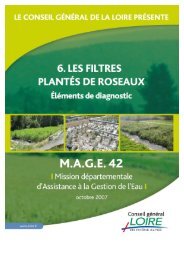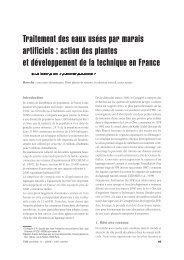Etat des lieux et expériences de réhabilitation des ... - Epnac - Irstea
Etat des lieux et expériences de réhabilitation des ... - Epnac - Irstea
Etat des lieux et expériences de réhabilitation des ... - Epnac - Irstea
You also want an ePaper? Increase the reach of your titles
YUMPU automatically turns print PDFs into web optimized ePapers that Google loves.
Partenariat 2011Domaine : Ecotechnologie <strong>et</strong> pollutionsAction 25 – Vol<strong>et</strong> 3Overview of land extensive attached growth systems for urban wastewatertreatment and experiences of rehabilitation: open surface sand filter; un<strong>de</strong>rground sandand zeolite filtersFinal reportEPNAC group workABSTRACTThis study focuses on three land-extensive attached growth systems using sand and zeolite as boundingsubstrata. One process consists in open surface sand filter while the other two are un<strong>de</strong>rground systems,using sand or zeolite as filling materials. All three processes inclu<strong>de</strong> preliminary treatments.Since the 1990s in France, domestic wastewater treatment using attached growth biofilters has <strong>de</strong>velopedand this technique has been applied to small communities in size. However, due to ambivalent feedback, itappeared necessary to EPNAC working group to investigate at the national scale these three types ofwastewater treatment plants. This report encompasses results and analyses of a national scope survey,and s<strong>et</strong>s a critical analysis including the actual stocktaking of rehabilitation experiences for these threesystems.Studied processes performances are unsatisfactory. Clogging is the major operating issue and occurs infrequencies above 32% for all three studied processes. This situation is highly problematic since cloggedreactors are synonymous of severe treatment efficiency downgrading Thus, it prevents the contractingauthority to fulfil mandatory effluent discharge quality standards. Legal arguments on these treatmentpremises are almost exclusively linked to reactor clogging and affect from 9 to 21 % of clogged systems<strong>de</strong>pending on the studied process. Compl<strong>et</strong>e replacement of the wastewater treatment system is often aheavy expenditure, and more than 50% of the time, rehabilitation of existing infrastructure is the planned orperformed option.Rehabilitation of a malfunctioning wastewater treatment plant is necessary, especially since facilityreplacement can often be a time taking process, spreading over several years. Nevertheless, positiveimpact of easy and non-costly rehabilitations has to be assessed. Field experiment listed in this study havebeen analysed and evaluated.Only a precise analysis, on an individual case basis, of clogging causes taking into account hydraulic andorganic loads actually received by the reactors allows arguing for repairing and rehabilitation or for acompl<strong>et</strong>e change of the treatment facility. Though, it comes out the enquiry answers that facing a cloggingproblem actions to engage usually affects the entire wastewater processing chain, including sewagen<strong>et</strong>works and facility running tasks. In the <strong>de</strong>cision making process it is therefore necessary to take intoaccount the cost-benefit balance of small, cheap or temporary rehabilitations regarding more importantones, as well as the environmental impact due to malfunctioning or not functioning of the treatmentsystems and its potential duration.If trials recommen<strong>de</strong>d in this study were not satisfactory, treatment utility replacement has to beconsi<strong>de</strong>red. In comparing replacement options, it is pertinent to consi<strong>de</strong>r options including reuse of existingconstructions.KEY WORDSAttached growth bioreactor, clogging, sand filter, rehabilitation, FranceMars 2012 - p 8/56



